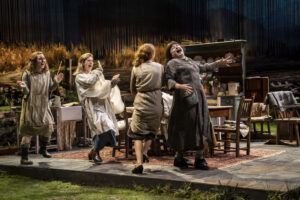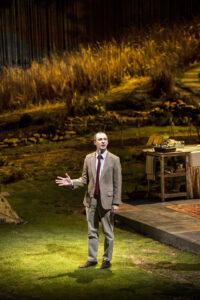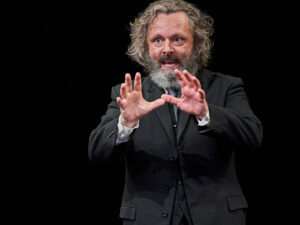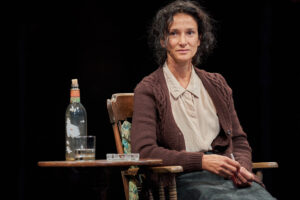Derry Girls fill the Olivier stage with their grand performances
★★★★

Brian Friel‘s Dancing at Lughnasa has come to be regarded as a modern masterpiece. The National Theatre first staged it straight after its 1990 Dublin premiere. Now this intimate play is back there on the huge Olivier stage in a new production directed by Josie Rourke.
Siobhan McSweeney and Louisa Harland from Derry Girls play two of five unmarried sisters approaching middle age whose life is suddenly upended in 1936. The story seemed relevant to 1990, but does it still seem like a masterpiece 30 years on?
Dancing at Lughnasa is a multi layered play which is part of the reason it’s so riveting to watch. For a start, it’s a memory play, which in this case means that a narrator tells us at the beginning and at points during the evening that what are witnessing is from his memory, mainly from when he was seven years old. So straightaway, the play raises questions about the reliability of memory but also about the nature of writing itself. Did all that happens really occur in the space of a couple of months, or is it memory (or the writer) rearranging them for the sake of a more dramatic narrative?
This leads us to think about what is true- whether facts are truth or whether fiction tells us a greater truth about life. Ostensibly a play about five unmarried sisters, it is about human relationships universally: what holds them together, what may drive them apart. And those same questions apply to much larger communities.
Running through the play is the eternal battle between body and mind, id and ego. Lughnasa is an annual Irish harvest festival dating back to pre-Christian times, taking place at the beginning of August. It’s a time of all kinds of celebratory activities dedicated to pagan gods: walking up hills, picking wild bilberries, and, yes, dancing. So, while it was appropriated by the Catholic Church, in essence it opposes the asceticism of Christianity, and encourages physical release.
All this aside, its core is a funny and sad description of the lives of a family under pressure. The five sisters, who for one reason or another, are unmarried and live together, without parents, in poverty. They are moving into middle age realising they are too old to find a husband or indeed to dance. They still dream of doing both at the Lughnasa festival.
They rely almost entirely on the income from the oldest, Kate, who is a teacher. Kate is straightlaced and sees it as her job, to be a quasi-mother. Although she tries to hold firm to her Christian principles, the cracks in this façade constantly show. Played by Justine Mitchell, we feel the tension of her trying to hold herself aloof but constantly bewildered and tempted by her wilder sisters. And she shows her joy when she lets herself go.
Maggie is the heart of the home. She cooks and plays, she also has the clearest vision, realising what feelings are being suppressed, and able to defuse tense situations with a joke or a song. Siobhan McSweeney, whom many will recognise from the TV series Derry Girls, is tremendous in this complex role. Just to spend the whole evening watching her eyes, sizing up situations and wondering how best to respond, would be a masterclass in acting.
Agnes and Rose provide the household with some additional income by making gloves. Agnes, played by another Derry Girls alumna Louisa Harland, is quiet; Rose, played with sensitivity by Blaithin Mac Gabhan, has a learning disability. The others recognise her vulnerability and the need to protect her, at which they are not always successful.
The youngest sister Chris is the unmarried mother of Michael who, as an adult, is our narrator. Alison Oliver gives her a brittle naivety, particularly remarkable is the way she comes to life when she sees her child’s father.
The power of dance
We are told by the narrator, played by Tom Vaughan-Lawlor in flat, almost neutral terms, what is going to happen, and, at the end, what happened after the family broke up. This makes watching the play is akin to watching a car crash in slow motion.

Director Josie Rourke deserves every award going for the way she has brought this production together. I’ve already indicated that the casting is perfect., but there is also the challenge of presenting an intimate play on the enormous Olivier stage. Her designer Robert Jones achieves this by creating a circle that follows the arc of the edge of the thrust stage. Within that is placed a really quite small platform representing the main living area of the house, thus retaining the play’s intimacy. In front of this room is a yard or play area, a space mainly occupied by the child Michael (whom we never actually see, as everything is seen by him). Behind, a hill rises, (a metaphor perhaps for this family being at the bottom in society, but also a nod to the hill climbing that is part of Lughnasa rituals). At the top is ripe corn ready to harvest and at the back what look like hanging string or chain curtains onto which are projected images of the sky but which also seem to trap the people below.
In Josie Rourke‘s precise direction of the cast around the tight living area, you can literally see how close the sisters are physically as well as emotionally. when they trek away from the house, you feel the separation.
So what are the disruptive events that destroy this family? Firstly, there is the arrival of two men, both in their different ways damaging the reputation of the family. They are caricatures compared with the sisters but this can be interpreted as being Michael’s memory of them. It does have the effect of making them very amusing.
The sisters’ older brother Jack returns from missionary work in Africa, mentally confused at first, but eventually revealing his change from Catholic priest to believer in paganism. It’s an hilarious performance from Ardal O’Hanlan, as he talks almost in a stream of consciousness, oblivious to the effect on others of the shocking things he is saying. One of the funniest moments is when he keeps unconsciously grabbing a sheet his sisters are attempting to fold, symbolising his disruption of their ordered world. His rejection of Catholicism seems to be the reason Kate loses her teaching job, and the family her income.
Michael’s father, a feckless charmer called Gerry, also turns up. Something of a man-child, he appropriately spends most of his visits in the garden, making many promises he cannot keep before disappearing again. Having tried and failed at many jobs, he has decided to join the International Brigade, who are fighting for democracy against the catholic church-supported dictator Franco. Played by Tom Riley, he is a likeable character, and he loves dancing. Dancing seems to be the thing that still unites him and Chris. And dancing is in the title of the play for a reason.
Which brings me to the third disrupter: the new wireless set. It is not news from the outside world that changes their lives, but music, because hearing music inspires them to dance.
As the narrator tells us: ‘Dancing as if language had surrendered to movement- as if this ritual, this wordless ceremony, was now the way to speak, to whisper private and sacred things, to be in touch with some otherness.’
Two of the best scenes in this production are once when Irish music plays on the radio and, slowly but then with increasing pace, the sisters start to dance, even eventually Kate, until they are frenetically jigging round the tiny kitchen, jumping and high kicking with abandon. It’s a glorious moment, thanks to the women of the cast and choreographer Wayne McGregor. Then, later in the play, when Anything Goes is playing on the wireless, two of the characters combine in an erotic dance that reveals their feelings, and changes relationships forever.
Then there is the glove factory that opens- the industrial revolution has finally arrived in their small corner of Ireland- and it puts Aggie and Rose out of work.
So this small community is a microcosm of what happened to Western society as a whole, as seen from the end of the 20th century. The family dynamics at the centre of Dancing at Lughnasa remain fascinating and totally believable, and the dialogue is still a joy. But, nearly a quarter way through the 21st century, we have moved on. Now we are grappling with the changes wrought by digital technology which in very different ways is revolutionising our society and the way we relate to one another. Consequently, the play’s nostalgia isn’t what it used to be, and it no longer packs quite the punch it once did.
Nevertheless, a great production of a still brilliant piece of writing.
Dancing at Lughnasa can be seen at the National Theatre until 27 May 2023
Paul received a complimentary review ticket from the theatre
3 May 2023: I might have added when talking about Siobhan McSweeney’s acting skills that all the sisters use their eyes to great effect.

